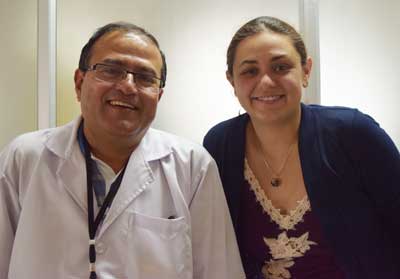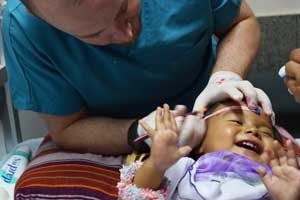Epigraph Vol. 17 Issue 3, Fall 2015
The Bhutan Epilepsy Project

The Bhutan Epilepsy Project is a prospective study in the Himalayan Kingdom of Bhutan, a small landlocked country of less than one million people. Bhutan is a unique location with its combination of traditional beliefs and promulgation of gross national happiness, which is the measure by which Bhutan determines its national development.
Like many countries worldwide, Bhutan lacks a neurologist. Therefore, epilepsy care de facto becomes the purview of primary health care workers and other specialists. Epilepsy patients in Bhutan are seen through the Department of Psychiatry's Outpatient Clinic at the Jigme Dorji Wangchuck National Referral (JDWNR) Hospital in Thimphu, Bhutan's capital. It is an approximately 350-bed hospital with several outpatient clinics and was named after the king who died in 1972. Dr. Damber Nirola, the head of the Department of
Psychiatry, cares for several hundred epilepsy patients. Pediatric patients are managed through the country's pediatricians and health care workers. In general, approximately half of Bhutanese patients self-report that they also receive care through the prevalent traditional medicine services available in the country.
There were several reasons for choosing Bhutan for this project, first and foremost of which is the absolute need for epilepsy services and care. Second, in view of its "developing economy" status, Bhutan is an excellent place for introducing disruptive technologies. Because it has a high rate of mobile phone ownership, the country lends itself well to the use of these phones for epilepsy related apps. For example, there were previously no EEG technicians or working EEG machines in Bhutan, but the project has implemented the use of a mobile phone app coupled with a 14-lead headset. This technology allows EEGs to be recorded at one site but read in other countries. Further, because Bhutan has a rugged terrain with many rural communities, there are frequent difficulties with transportation. Finally, there is a high burden of epilepsy.

The Bhutan Epilepsy Project has enrolled approximately 275 people with known epilepsy or suspected seizures since summer 2014. The main research goal is to characterize risk factors, awareness, and diagnosis of epilepsy in Bhutan. The project employs a smartphone-based electroencephalogram (EEG) app, the Smartphone Brain Scanner-2, designed by my collaborators at the Danish Technical University (Arek Stopczynski, PhD and Lars Kai Hansen, PhD). The smartphone app has several advantages in lower-income settings where neurologists are relatively few or absent. For instance, the app is battery-powered, compatible with headsets with pre-positioned leads on "caps," user-friendly, and much less costly than standard EEG.
The Bhutan Epilepsy Project involves a team of more than 30 people in several countries to bring epilepsy research and care to Bhutan. Dr Nirola leads the current care of epilepsy patients at the JDWNR Hospital. Dr Nidup in the Department of Radiology supervises MRI acquisition and interpretation, and Dr Tshokey and Ms Sonam Paydon in the Department of Pathology perform T. solium testing in blood for the diagnosis of neurocysticercosis.

The access to technology and new human resources for health among Bhutanese people with epilepsy in our study is meant to improve their epilepsy management for the long term. The Bhutan Epilepsy Project has involved many colleagues from Massachusetts General Hospital, Sunnybrook Hospital in Toronto, and the University of Manitoba. Their skills include epilepsy treatment, neurocritical care, EEG technology use, and EEG interpretation.
In Thimphu, we depend on Sonam Deki, BComm and Lhab Tshering, BSc, for project management as well as translation, organization, and continuity to the project. They are essential to all aspects of the project by making it relevant and sensitive to the local context. In Boston, our project is coordinated nearly full time by Sarah Clark, BSc, who leads data quality control and international coordination among the many co-investigators.
So far, we have amassed nearly 1,000 EEGs, including the first neonatal EEGs performed in Bhutan (Figure 1). In addition, we have provided clinical recommendations for many Bhutanese people living with epilepsy. Participants have come from all 20 districts of the mountainous country. In addition, I was a guest on an hour-long epilepsy awareness radio program for Sun Valley Radio in Thimphu, and the team has collaborated with Athang Studios to produce an epilepsy awareness cartoon with the Bhutanese hero, Ap Bokto, which was released in late summer 2015 (Figure 2). To get a sense of the country and people please look at our short film entitled The Curse (View video here), which received the American Academy of Neurology's 2015 film festival award. It was directed by Discovery Himalayas in Bhutan and depicts the story of Karma, a young boy who died of epilepsy — likely due to an unintentional injury — in rural Bhutan. Karma's story reminds us of the tragedy of epilepsy in countries where we have more work yet to do.

Financially, we are thankful for the support of Massachusetts General Hospital, Grand Challenges Canada, Thrasher Research Foundation, and an educational grant of the World Federation of Neurology as well as travel grants from various sources including the Massachusetts General Hospital Center for Global Health and Partners Innovation Center.
The Bhutan Epilepsy Project has grown well beyond the humble ambitions we started with, incorporating community outreach, full time local staff, and emerging technologies for more than twice the number of participants than we had originally thought we would enroll. We are thankful for the opportunity to work in Bhutan, to mutually educate North American and Bhutanese people, and to attempt to sustainably improve the status and care of people with epilepsy in Bhutan (Figure 3). We are now in the second year of the project and are keen to continue our project for the longer term in Bhutan and beyond. We hope this project can become a model for developing epilepsy programs in countries with limited resources and expertise.
Submitted 26 July 2015 by Farrah Mateen, MD, PhD, Massachusetts General Hospital & Harvard Medical School, Boston, MA, for the ILAE newsletter. Revised October 23, 2015.
Subscribe to the ILAE Newsletter
To subscribe, please click on the button below.
Please send me information about ILAE activities and other
information of interest to the epilepsy community